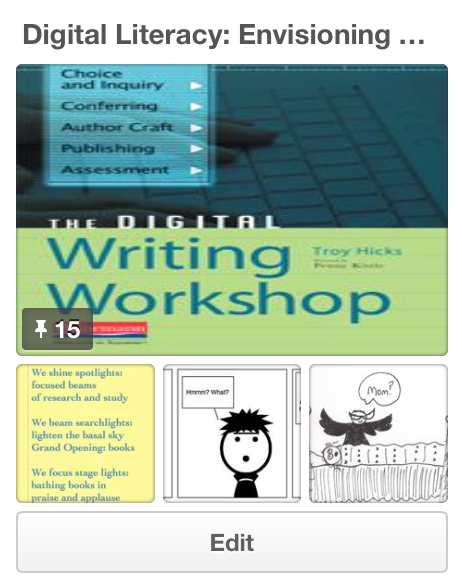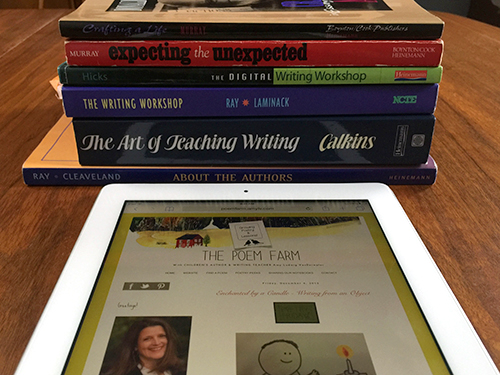Chapter 1: Transitioning Toward Digital Literacy
1.6 Making the Shift
It’s interesting to live in a time of transition as we move from a world of paper print toward greater use of digital spaces to share information; the remnants of our print world all around with new digital devices scattered about. The set of bound encyclopedias we bought for our children when they were quite small seemed a good idea to help them to learn, but by the time they really needed them they were looking up everything on their phones. Our family photos no longer live in a scrapbook, but are stored in digital folders or shared in digital spaces for others to see. Our trips are no longer taken with a paper map in hand, but instead our phones set to the destination. (Okay, sometimes I still like a map.) Years from now, we probably won’t think twice about the transition from print to digital literacy. Is this transition as evident in our classrooms as it is in our daily lives?
The need for change became evident one day as I visited the Apple store and became fascinated as I watched several four, five, and six year olds sitting at a small table with iPads. They were just working away. They easily moved through menus. They worked until they figured things out. These kids were about the same age as the students in my classroom; I remember thinking how mismatched our days in the classroom were to this new world they were already living in each day. I knew I had to find ways to make changes.
As I grew more comfortable in this new world of literacy, the work I was doing in my classroom became more uncomfortable. The way I was living in the digital world had added new excitement, built my interest, grown my learning opportunities, and offered new options. Shouldn’t my students have some of these same opportunities to learn, to share, to connect, and to collaborate? Shouldn’t they have alternate possibilities for collecting ideas and composing? Shouldn’t they have opportunities to read in digital spaces and use different tools? Shouldn’t they be able to reach out to others and build their own learning communities? Each day I would walk into my classroom and realize the literacy work we were doing was largely disconnected from real world literacy. I knew I needed to make a change.
The world is much different now than it was when I first started teaching. In my beginning years of work as an educator, my focus was on helping my students learn how to read and write. I set up reading groups and supported students as they worked to grow their reading strategies. We had daily opportunities to write to help students become better writers, but our writing rarely made it beyond the four walls of our classroom.
I began to realize that digital opportunities could open new doors for my students. The print books available to my students are no longer the only kind of text they need to learn to navigate. The paper they write on during writer’s workshop is no longer their only option. I am no longer the only audience for their work. Our work can now reach beyond our community. Experts are now at our fingertips. These digital opportunities reshape the work we do in our classroom and provide new possibilities in learning.
I used to think we should all jump on the digital bandwagon when we were ready. I’ve come to realize that our students can’t wait until we are ready. We have a responsibility to learn the things we need to know in the best interest of our students. Sometimes I hear people say, “We need our classrooms to be places where children prepare for their tomorrow.” I’m thinking we need classrooms that have them living in their today before we can even move to that. Digital spaces provide students with a voice today.
In those first days of going digital, much like in learning a new tool now, I just had to take one step at a time. Yes, I learned to use digital tools purposefully, but I also knew I needed to stay grounded in solid pedagogy as I transitioned these tools to the classroom. The understandings I had gained from literacy leaders like Marie Clay, Gay Su Pinnell, Regie Routman, Debbie Miller, Donald Graves, Shelley Harwayne, Lucy Calkins, and Katie Wood Ray still whispered in my ear. Real reading and writing opportunities mattered. Students still needed to learn strategies for reading, build comprehension, understand writing craft, and learn to compose in meaningful ways. Students needed time to read and write daily, but I knew it needed to start to look different. I didn’t want to use digital tools just because it was a cool thing to do, but instead to see how these new opportunities could amplify their voice and grow their learning community. I wanted to think about how they could enhance the learning we were doing. I wanted to think about how they could open new doors for learners.
To get started I began to look for experts who seemed to be figuring out how to use digital literacy in their classrooms. I found professional books where authors shared new possibilities and helped to shift my thinking. Will Richardson’s, Why School?, made me ask hard questions about brick and mortar schools. The first book I read with a digital focus was The Digital Writing Workshop by Troy Hicks. It really shook up my thinking about literacy. It was his book that first opened my eyes to new possibilities and pushed me to move beyond my current understanding of literacy. Reading Alan November’s Who Owns the Learning, pushed me to think about student ownership in learning. These were among the first books that started to make me feel the urgency of the change I was trying to make.
Though books shaped these first steps, live content on the internet probably did even more in helping me to get started. When have we been able to read the thinking of experts from around the world seconds after they press the publish button? Having continual access to this fresh thinking, and being able to see the work students produce, to step virtually into classrooms, and to read reflections of educators, has kept pushing me forward.
Leaders of change like George Couros (Principal of Change), Jackie Gerstein (User Generated Education), and Scott McLeod (Dangerously Irrelevant).
Leaders of digital literacy like Franki Sibberson (A Year of Reading), Kristin Ziemke (Ignite. Innovate. Inspire.), and Troy Hicks (Troy Hicks’ WordPress Blog).
Digital writing mentors like Amy Ludwig VanDerwater (Poem Farm), Kevin Hodgson (Dogtrax), and Laura Purdie Salas (Laura Salas).
Teachers of primary students like Kathy Cassidy (Primary Preoccupation), Katie DiCesare (Truth Joy Possibilities), and Deb Frazier (Primary Perspective).
See my digital literacy mentors on my Pinterest board.

